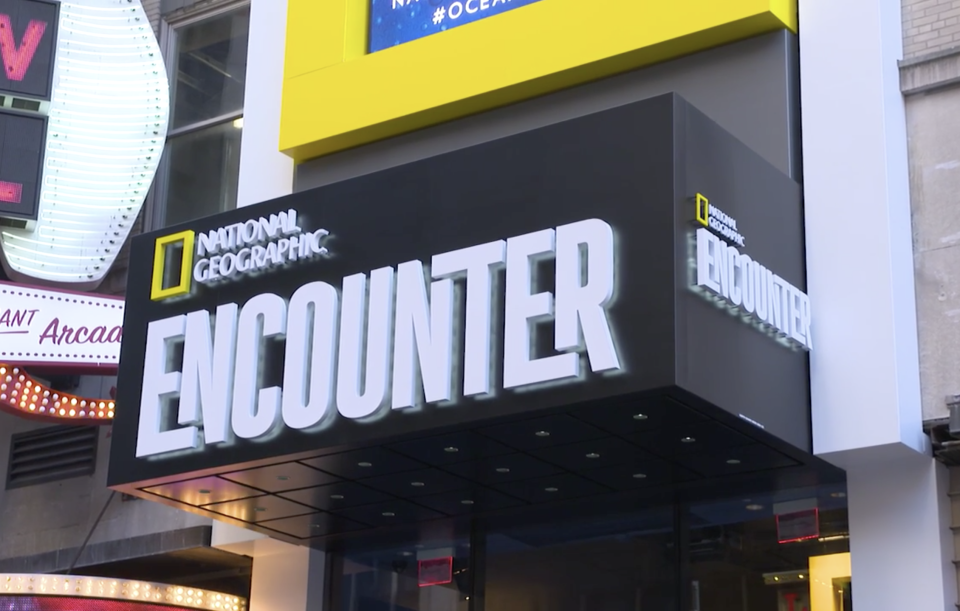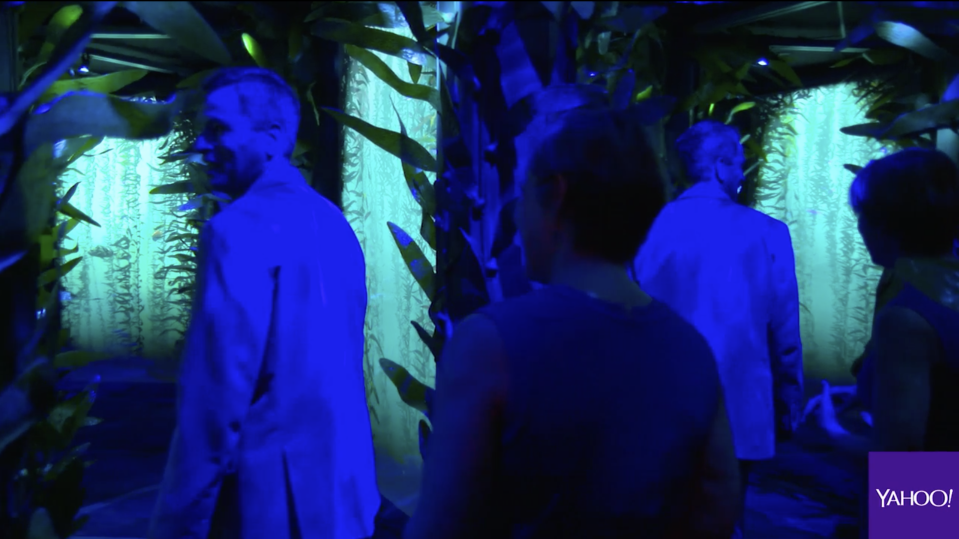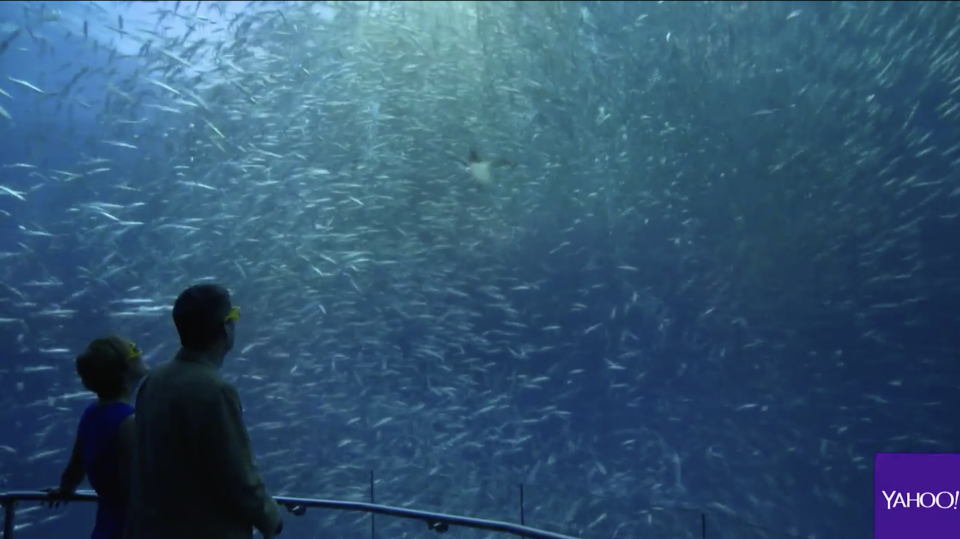Nat Geo's Ocean Odyssey in Times Square: Moments of awe for $40
If you’ve walked anywhere in New York City lately—or anywhere in its subway system—you’ve seen the big posters for National Geographic Encounter: Ocean Odyssey, the multimillion-dollar tourist attraction that just opened in Times Square.

(Why does it have a 15-syllable name? Because Nat Geo has taken out a 15-year lease on a building on West 44th Street, which will always be called National Geographic Encounter. The first attraction there is Ocean Odyssey, but that could change. It may one day give way to, you know, NGE: Arctic Adventure, NGE: Safari Story, or NGE: Nebraska Cornfield.)
The wording of the ads makes it sound like you’re in for a watery time: “It’s the ultimate undersea experience. You’ll be ocean floored!”
In fact, though, the only water you’ll find at NGEOO is in the drinking fountains. The entire attraction is created with movies and sound effects. These are very, very high-end movies and sound effects, but basically, that’s what you’re in for.
You walk with a group of other visitors through a series of about 10 darkened rooms, each of which presents an undersea scene with a twist. In the first room, for example, the projected video curves from the wall in front of you to the floor beneath your feet—and the fish, rays, and sharks that swim lazily across that floor respond to your feet. If you try to step on them, they scurry away. Like many of NGEOO’s rooms, this one will find its greatest fans among children, who love to chase or corral the sea critters.

The next room involves much less activity: It presents the sights and sounds of the darkened ocean at night.
When you’ve had enough undersea after hours, you mosey into a dark room with movie screens on two facing walls. They display an energetic battle between two Humboldt squids, whose tentacles are lined with razor-sharp teeth and who, apparently, you don’t want to mess with. (This part might frighten some of the younger undersea explorers.)
Next up: A hall of mirrors, copiously festooned with plastic strands of kelp. Mirror mazes are always fun, and this one is, too, although you don’t learn much about the ocean.

If you ever find your way out of the kelp maze, you get to stand in front of a tall, thin video screen that depicts an adorable sea lion, facing you as though in a tank on the other side of a window. You can actually control your sea lion with hand motions. Whisk both hands upward to make him do an acrobatic back flip, draw a circle with your hand to make her do a “donut,” and so on.
You know who would love this part? Kids.
The strongest exhibit is a massive 3-D, 8K movie. You wear 3-D glasses and stand directly in front of a huge, curved movie screen. Because you’re so close, the projected image fills your entire field of view—and because it’s 3-D, the scenes you’re watching have a heightened sense of realism.
(The “8K” part refers to the resolution of the video—it packs 4 times as many pixels into each dimension as the hi-def TV you’re probably watching now. It’s very, very sharp when you stand right up close. And for added smoothness, this video plays 60 frames a second—twice the frame rate of TV. Creative director Lisa Truitt told me that computer-generating this short movie required nearly one day of rendering per frame, since it’s a separate, 60-frames-a-second 8K video for each eye in 3-D.)

So what’s the movie? It’s like an underwater Imax thrill ride. You see a bait ball (a massive, seething ball of tiny fish), sharks coming and going, and, at the end, an absolutely massive whale that chases them all way—and takes your breath with it. It’s a lot like being inside a virtual reality game, without the isolation; it’s a social experience, and the highlight of NGEOO.
At the end of these adventures, you wind up in a pair of learning rooms, where you can listen to experts tell you more about the ocean—and what’s in it. (Increasingly, the answer is: human trash.)
Nat Geo estimates that the entire exhibit takes about 90 minutes to complete. But unless you spend a lot of time in line—apparently a frequent prospect—you can really finish up the whole thing in under an hour.
For this experience, you pay $40, or $33 for a kid. That’s a very steep ticket, especially for a family. National Geographic points out that a portion of the ticket price goes to support Nat Geo’s nonprofit mission, which includes protecting the oceans. Still, the price helps explain why the attraction, overall, earns only a 2-star average (out of 5) on Yelp.
“Overall, I felt the experience lacked context about what I was seeing, and so there wasn’t much learning,” says one reviewer. “It seemed like I had been watching a really large aquarium screen saver.”
Here and there, you can find moments of joy and awe in these rooms. Unfortunately, with its marketing and its pricing, Nat Geo may be over-promising and under-delivering. NGEOO may be discovering that it’s hard for us to be enchanted by the oceans—when we feel we’ve overpaid and been underwhelmed.
More from David Pogue:
iPhone X review: Gorgeous, pricey, and worth it
Inside the Amazon company that’s even bigger than Amazon
The $50 Google Home Mini vs. the $50 Amazon Echo Dot — who wins?
The Fitbit Ionic doesn’t quite deserve the term ‘smartwatch’
Augmented reality? Pogue checks out 7 of the first iPhone AR apps
David Pogue, tech columnist for Yahoo Finance, is the author of “iPhone: The Missing Manual.” He welcomes nontoxic comments in the comments section below. On the web, he’s davidpogue.com. On Twitter, he’s @pogue. On email, he’s poguester@yahoo.com. You can read all his articles here, or you can sign up to get his columns by email.


